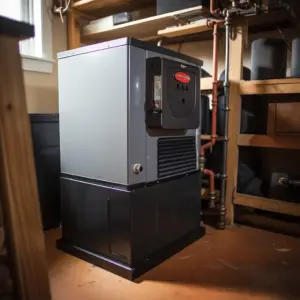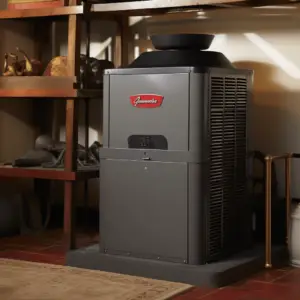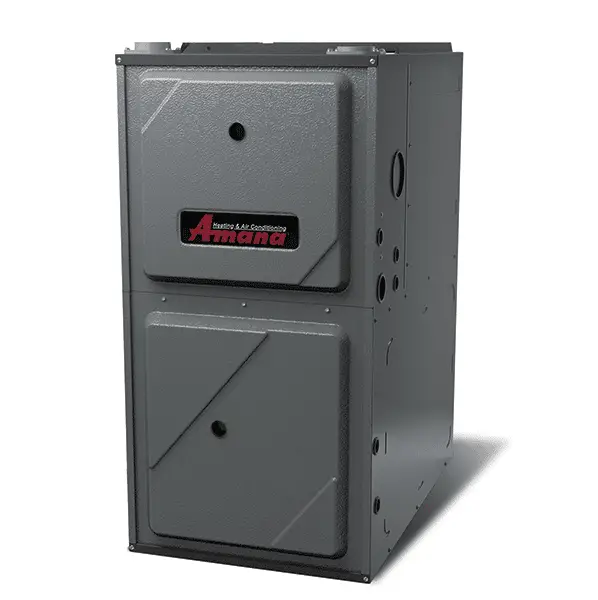Goodman and Amana furnaces are at the top of their game in the HVAC industry. These two companies make some of the best HVAC products on the market that are also affordable. But, which one is better?
It’s important to know what makes them different. The following article will discuss some of the basic similarities between the two brands.
Table of Contents
Amana vs. Goodman Furnace: Are they the Same Company?

Yes, Goodman is the parent company of Amana, and they are essentially the “same” company. Goodman acquired Amana in 1997.
They are owned by the same company, so they use all of the exact same parts. All of their furnaces are built by the same manufacturer in Tennessee. The main differences between them come down to efficiency rating, size, and features.
Both Goodman and Amana make gas furnaces that can reach around 96% efficiency. This makes them extremely efficient and will save you a significant amount on your heating bills compared to older models or lower-efficiency models from other manufacturers, especially when combined with an air conditioner from either brand.
Let’s look at some of their identical furnaces.
Goodman and Amana Single-stage Furnaces
In a simple on/off system, a single-stage furnace only operates at full capacity when it is turned on. The most basic models in each brand’s lineup come with 80% efficiency ratings.
However, because they only have one stage of heating capability, these furnaces may not be ideal for keeping your home as comfortable as you would like.
pros:
- More affordable than multi-stage furnaces
- Simple operation and maintenance
- Ideal for homes with lower heating needs
cons:
- Likely to be noisier than other types
- Less efficient than modulating furnaces, meaning higher energy costs over time
- Because they cycle on and off frequently, they can’t maintain as consistent a temperature as the other models.
Goodman and Amana Two-stage Furnaces
Two-stage means the furnace will operate on low heat for most of the time. Then if the temperature drops too low, the furnace will switch to high heat until it reaches your desired temperature again. This allows you to save money on your energy bills while still keeping your home comfortable.
They have a much quieter operation than single-stage furnaces because they don’t run at full speed all of the time. Instead, they cycle on and off at different speeds depending on your home’s temperature.
Pros:
Two-stage furnaces provide a more consistent home temperature by operating in high or low mode rather than constantly switching back and forth between the two settings like single-stage furnaces do.
This reduces wear and tear on the furnace, which can increase its lifespan by 30%. It also requires fewer repairs over time because there’s less stress being put on any one part of the system.
Cons:
Two-stage furnaces cost more than single-stage ones due to their added complexity and the higher price tag for installation labor hours. The efficiency options are limited to 80% and 96%, whereas with single-stage models, you can find efficiencies as high as 98% AFUE (Annual Fuel Utilization Efficiency) ratings.
Goodman and Amana Variable-Capacity Furnaces
Variable-capacity furnaces provide a lot of the same benefits as two-stage furnaces but with an important additional advantage: they can modulate their heating output from 40% to 100% capacity.
That means that when the furnace is running at a low capacity, it can run at any capacity between those two extremes. The effect is to allow the furnace to match the heat output exactly to your home’s demand for heating.
Pros:
- Cooler operation with a variable-speed blower means quieter operation and better dehumidification for the home.
- The furnace runs at more efficient lower capacities more often than with a single-stage furnace
- Airflow during heating cycles is variable and matches your home’s demand for heating.
Cons:
- More complex technology than other furnaces; therefore, they are more likely to need repair and have shorter lifespans.
- More expensive to purchase and install than other types of furnaces.
Furnace warranties: Goodman vs. Amana
The main difference between Goodman vs. Amana furnace warranties is that Amana offers the best warranty — a lifetime replacement warranty — on most of their furnaces. In contrast, Goodman only includes this warranty on a few models. Otherwise, warranties are similar: the difference is in their heat exchanger warranties.
Goodman Gas Furnace warranty
Any brand can have a bad heat exchanger. Goodman is not immune to furnace problems, but the company’s warranty coverage is among the best in the business.
Goodman offers three warranty tiers for heat exchangers:
Lifetime warranty with lifetime furnace replacement: Heat exchanger failure means you get a new Goodman furnace at no charge.
10-year furnace replacement: If the heat exchanger fails in the first decade, it’ll be replaced free of charge, but after that, you’ll get a new furnace instead.
Lifetime warranty with heat exchanger replacement: The most basic option. If your heat exchanger fails during its lifetime, Goodman will replace it free of charge.
Amana HVAC warranties

Amana expressly gives you a choice between two different warranties.
Lifetime warranty with lifetime furnace replacement: This warranty covers the heat exchanger for life and requires them to replace the entire furnace if it’s damaged.
Lifetime warranty with heat exchanger replacement: This warranty also covers the heat exchanger for life but only requires them to replace the heat exchanger if it fails.
For either warranty, you have to register your furnace within 90 days of purchase. If you don’t, then you get a base warranty of 10 years on parts and a 20-year limited heat exchanger warranty.
HVAC Warranty Transferability: Your HVAC warranty is non-transferable. That means if you sell your home during the terms of your warranty, it won’t be available to any subsequent homeowners.
Goodman vs. Amana Furnaces: Our Verdict
If you’re trying to decide between the two, here’s what you need to know about Amana vs. Goodman gas furnaces:
It comes down to this: Goodman has lower prices while Amana offers better warranties on some of their furnaces. But the overall quality of each brand is pretty much the same.
Both brands make furnaces that meet Energy Star standards for efficiency, so choosing one over the other will not make a difference in terms of energy savings.


